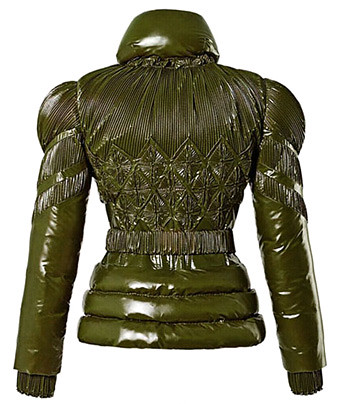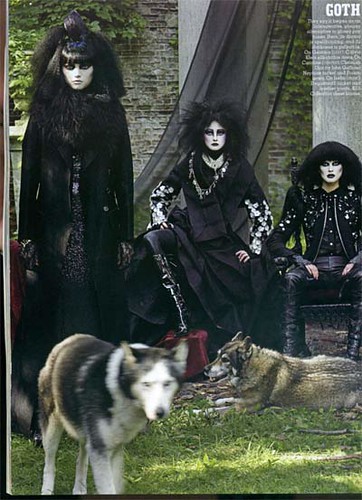
I always hated the writing of Lovecraft – how many tedious descriptions of shrubbery can you bear? – but paradoxically adore everything that’s inspired by his work, from Cthulhu Sex Magazine to the song “Colours Out of Space” by Evil’s Toy to stories like “Shoggoth’s Old Peculiar” by Gaiman to the Tigerlilies/Alexander Hacke Mountains of Madness project to Hello Cthulhu to, most recently and hilariously, to LOLCTHULHU macros. Like a bad song that reveals itself to be a masterpiece after a good remix, the Cthulhu Mythos lend themselves to brilliant interpretation time and time again.
In its most recent incarnation, Lovecraft’s work is to become a film called CTHULHU. The film deals with gay themes, anti-Bush sentiments, the Apocalypse, an it features – get ready for this – Tori Spelling! As some fans have already commented, sadly and quite surprisingly Spelling does not play Cthulhu. Go watch the trailer right now.
Posted by Nadya Lev on September 28th, 2007
Filed under Cthulhu, Film | Comments (6)
Stalin, or “Good Ol’ Uncle Joe” as he was called in America before the tides turned, liked to have fancy titles bestowed upon him in Russia. Below are some of the most epic:
- Coryphaeus of Science
- Father of Nations
- Brilliant Genius of Humanity
- Great Architect of Communism
- Engineer of Human Souls
- Gardener of Human Happiness
- Experienced Helmsman of Our Revolutionary Vessel
Source: Wikipedia. These handy for generating a title for yourself on the Brass Goggles Forum. All aboard Airship Stalin!
Posted by Nadya Lev on September 28th, 2007
Filed under Russia, Steampunk | Comments Off on Stalin: Best Friend of All Cows and Milkmaids
“Honor to the Futurists who forbade the painting of female hams, the painting of portraits and guitars in the moonlight. They made a huge step forward: they abandoned meat and glorified the machine.”
– Kasimir Malevich, 1918
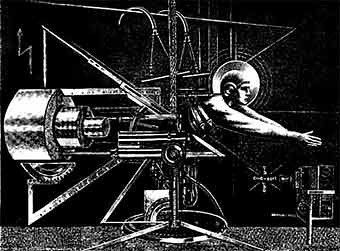
Image by Russian industrial musician Alexander Lebedev-Frontov.
In 1921, Russian physicist Lev Theremin, an inventor who insisted on building all his creations by hand, constructed the theremin, one of the 20 th century’s first successful electronic musical instruments and still the only music instrument whose haunting tones are elicited without touching the device. Unlike Theremin, neither famous theremin-users John Cage, Download, Brian Eno, Meat Beat Manifesto or Edgar Varese were ever arrested for its use. After a decade of teaching and performing, Theremin was suddenly seized and imprisoned in 1938 by the KGB on the grounds of “anti-Soviet Propaganda.” Theremin was sent to Siberia and later to a labor camp in Omsk, where, alongside other indentured scientists, he was forced to work on various military projects (Theremin was later given the Stalin Prize for perfecting the eavesdropping device known as “the bug”). Thus begins the history of industrial music in Russia…
Posted by Nadya Lev on September 9th, 2007
Filed under Music, Russia | Comments (3)

Paris-based 24-year-old photographer Andy Julia is a versatile artist whose commercial work has sincere gothic sensibilities, and whose gothic personal work creates an intimate vintage atmosphere. Andy became known in the alt world through his contributions to Elegy Magazine, and chats with Coilhouse about his first photoshoot, his new book, agency models vs. alt models and other interesting topics below:
Do you remember the first photo shoot you ever did?
Yes I remember perfectly. I was a 17 years old teenager who’d just discovered the sense of love. I began my first roll in shooting my girlfriend innocently. I was unconscious of what photography was, and felt really out of all material conditions…
This first roll had a very hard light, supplied by a simple bedside light. Her skin was wrapped in a piece of black satin, and her legs hidden behind beautiful stockings, she was wearing a black velvet men’s “Haut de forme” from the end of the 19th century…our bed was surrounded by mirrors. We just made only one roll this day, as the teacher asked to us at the Beaux Art school, to learn how to develop and to print photographical pictures. This roll changed my life forever, and I was not conscious of that.
Posted by Nadya Lev on September 5th, 2007
Filed under Adornment, Art, Fashion, Interview, Photography | Comments (6)
Posted by Nadya Lev on September 4th, 2007
Filed under Fashion | Comments (2)
Posted by Nadya Lev on September 2nd, 2007
Filed under Adornment, Fashion, Future, Technology | Comments (6)
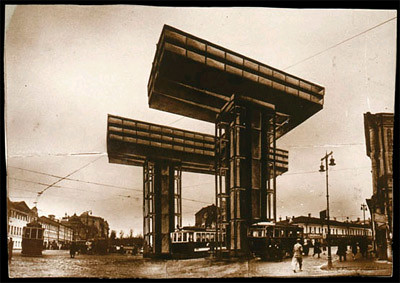
This building is called the Wolkenbügel, or Cloud-Iron. It was designed – though never built – in 1925 by artist El Lissitzky. That’s right – 1925! As in many of his other works, which spanned vastly different media, the Wolkenbügel underscores Lissitzky’s belief in the beauty of industrial production and a desire for pure monuments of technological progress.
There’s something very dark about Lissitzky’s propaganda art. Not dark in any sort of contrived “I’m trying to scare you” kind of way; on the contrary, his still, supreme and aphotic images are filled with nothing but love.
Posted by Nadya Lev on September 1st, 2007
Filed under Art, Russia, Technology | Comments (5)
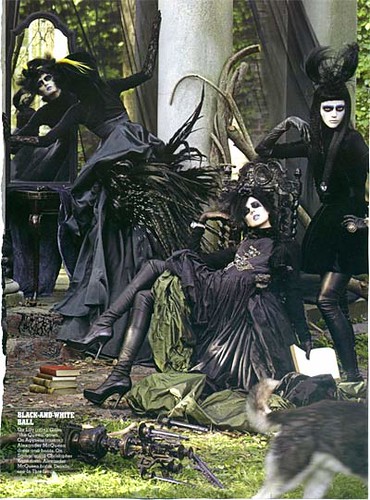
W Magazine Goth Spread, originally uploaded by Coilhouse.
Originally posted by my friend Kat – see her entry for larger pics of the above.
Posted by Nadya Lev on August 30th, 2007
Filed under Fashion, Goth, Photography | Comments (7)
Latest news stories reveal that the the Thor Equities plan to destroy Coney Island as we know it is dead in the water. And what a shame!
Listen, I know that Coney Island is a magical pocket of time and space that feels like walking inside an endless antique funhouse mirror. I know the chill of entering The Ghost Hole. I know that no score in life is sweeter than getting Mad Max right in the face in a game of Shoot the Freak. And I’ll dislocate my neck again any day for a ride on the world’s oldest wooden roller coaster.
Knowing all this, how can I support the re-construction of Coney Island? Two words: “dystopian pleasuredome.” Some of the concept designs for the new Coney Island are so nasty, garish, lurid and kitsch, that it just might work. I hope they do it. In fact, I hope that the designs get even worse, for that will take it to a whole new level. Just look at this:

It looks like somebody took Second Life and extrapolated it into the real world – all you need are some flying penises and the picture is complete. I’m convinced that this is what Coney Island needs to become truly great again. At some point, the proposed concept drawings promised us a Coney Island filled with dozens of translucent mini parachute jumps, skyscraper-tall holographic projections, roller coasters that wind from building to building like curly monorails, a rooftop landing pad for blimps, and something called “The Freakenspiel” – a “merry-go-round and water fountain topped by a pyrotechnic elephant.” However, the latest renderings, in response to worldwide pressure to “Save Coney Island,” have been markedly more traditional and therefore boring. Nobody wants to see the same old carnival facades, devoid of the layer of unwashable grime and stories that made Coney Island so compelling. So blast it all to hell and bring on the Jellyfish on Sticks.
Posted by Nadya Lev on August 21st, 2007
Filed under Cirque, End of the World | Comments (5)
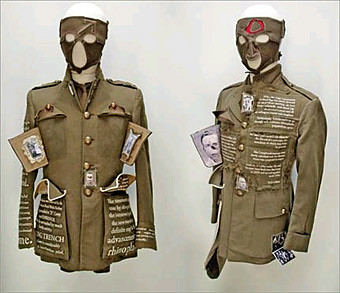
Paddy Hartley Project Facade, originally uploaded by Coilhouse.
Project Facade tells “the personal and surgical stories” of servicemen who sustained deforming injuries during World War One. The site displays the uniform sculptures as components of thoroughly-researched case studies that include the name, face and injury catalogue of each soldier, presenting a sculpture that’s unique for each man’s story. The most detailed case studies belong to Sea. AJ, Fai. W, and Top. V, though all are worth examining. Warning: there are images of facial deformities here that are not for the weak of heart!
Some uniforms are fragmented with blood-red stitching reminiscent of shrapnel wounds, others are inscribed with writing that conjures medical records or letters from loved ones, and many uniforms are complemented by stiff masks that project power and authority while hiding a the personal horror of a face literally erased by war. The project is two-fold: in addition to examining the history of facial/body reconstruction with the aforementioned uniform sculptures, Hartley also investigates modern techniques by creating Bioactive Glass Facial Implant sculptures, comparing today’s technology to the surgical techniques that Sir Harold Gillies pioneered in the early 1900s. The result is a powerful artistic response to the history of facial reconstruction, as experienced both by the patient and as the surgeon.
Posted by Nadya Lev on August 20th, 2007
Filed under Art, Medical, Uniform, War | Comments (2)






